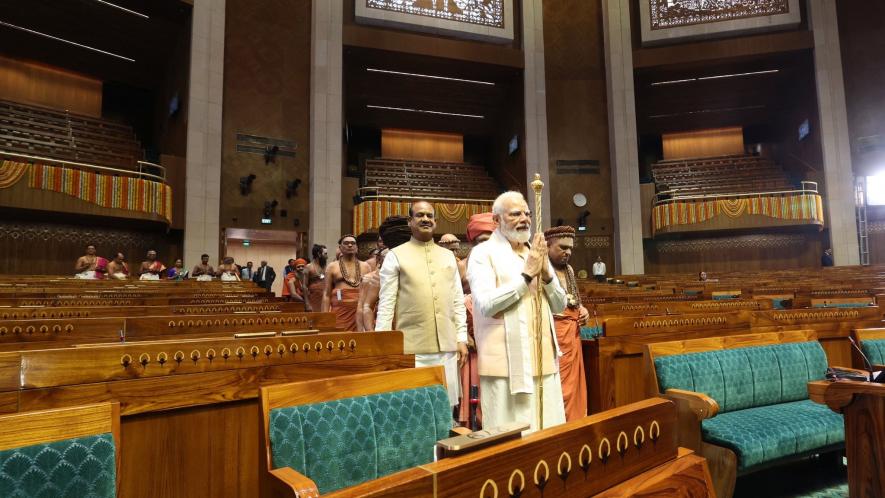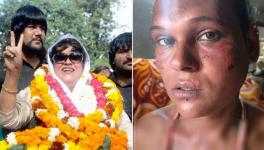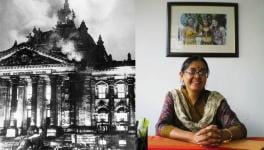Placement of Sengol in New Parliament Building and its Inauguration on Birth Anniversary of Savarkar Raise Questions on People as Source of Power

Image courtesy: @narendramodi (Twitter)
By placing the Sengol, a symbol of divine right to power, in the new Parliament building, and by inaugurating it on the birth anniversary of V.D. Savarkar, who supported the divine right theory, an attempt is being made to subvert the vision of India rooted in the idea that power and sovereignty rests with the people. Such an attempt is a negation of democracy.
Union Home Minister Amit Shah has come up with a unique, to say the least, theory on transfer of power from the British colonial government to the newly formed Union government of India. According to Shah, the transfer took place when the then Viceroy of India Lord A.V.N.L.F. Mountbatten handed over a Sengol, or gold-plated sceptre, to the first Indian Prime Minister Jawaharlal Nehru at the stroke of midnight of August 14, 1947. This was apparently done on the advice of statesman, writer, lawyer and independence activist C. Rajagopalachari. The problem with the theory is that it runs counter to available recorded facts and evidence.
Apparently, Rajagopalachari tendered that advice on the persuasion of Nehru, who was asked by Mountbatten to ascertain the ritual followed in India to mark the transfer of power. Rajagopalachari, according to Shah, drew Nehru’s attention to the age-old tradition of Tamil Nadu, where the Sengol used to be handed over by goddesses to the emperor to rule over their subjects justly, and asked Nehru to follow that practice of the bygone era associated with royalty.
Shah was attempting to justify Prime Minister Narendra Modi’s planned installation of the Sengol in the new Parliament building on its inauguration, scheduled today.
While goddesses handing over the Sengol to the ruler has been depicted in the murals of several temples of Tamil Nadu, in actual practice, royal priests belonging to the Brahmin caste used to hand over the Sengol to princely rulers. In other words, the Sengol is associated with the discarded approach that divine figures constitute the source of power.
Leading scholars deeply familiar with the writings of Nehru and Rajagopalachari have emphatically refuted the narrative spun by Shah.
How is the Sengol linked with the divine right to power?
The Sengol is associated with royalty. Representing such regalia is an anachronism in a modern democracy as ours. While the transfer of the Sengol from a goddess or a priest to a king represents the idea that the king derived power and sovereignty from that divine figure to rule, the modern form of democracy, instead of locating the source of power in any divine dispensation, traces it to the public, whose mandate is critical in determining the authority of elected representatives.
What was Nehru’s stance on the divine right theory?
Nehru moved the Objectives Resolution in the Constituent Assembly on December 13, 1946. It, among other things, declared the firm and solemn resolve of the assembly to proclaim India as an independent, sovereign republic and draw up for her future governance a Constitution wherein all power and authority are derived from the people.
The Sengol is associated with the discarded approach that divine figures constitute the source of power. Representing such regalia is an anachronism in a modern democracy as ours.
When some assembly members expressed their disapproval of Nehru’s assertion that people constituted the source of power and sovereignty, he charged them for upholding the divine right theory which enabled kings and queens to impose on people their power and authority that they asserted were derived from gods or goddesses. “We have heard a lot about this divine right of kings,” he said, forcefully adding, “We had read a lot about of it in past histories and we had thought that we had heard the last of it and that it had been put an end to and buried deep down into the earth long ages ago.” “If any individual in India or elsewhere raises it today,” Nehru remarked, “he would be doing so without any relation to the present in India.”
It sounds preposterous that Nehru, who spelt out in December 1946 that power flows from the people, would fall for accepting a Sengol from Mountbatten to mark the transfer of power from Britain at the midnight of August 14, 1947 when India attained her independence.
Is there any recorded evidence of Nehru accepting the Sengol from Mountbatten?
In Dr B.R. Ambedkar’s book Thoughts on Linguistic States published in 1955, there is a reference to Nehru accepting a raja danda (sceptre) on August 15, 1947 in Banaras to mark his assumption of office as Prime Minister of India. It is worth quoting the entire relevant paragraph of that book:
“Did not Prime Minister Nehru on the August 15, 1947 sit at the yajna performed by the Brahmins of Benares (sic) to celebrate the event of a Brahmin becoming the first Prime Minister of free and independent India and wear the raja danda given to him by these Brahmins and drink the water of the Ganges brought by them?”
What does the above para indicate? A plain reading of it brings out Dr Ambedkar’s critical remark that some Brahmins of Banaras celebrated Nehru, a Brahmin, becoming Prime Minister by presenting him a raja danda. It was done a day after the transfer of power took place.
Similarly, it was reported in The Hindu on August 15, 1947 that after the Constituent Assembly, at the midnight of August 14, 1947, announced the assumption of power and appointed Lord Mountbatten as the first Governor General of independent India, Nehru retired to an ante room where a brief religious ceremony was held, and a priest blessed Nehru and his mission.
Barring the above documented evidence that Nehru was blessed by a priest and offered a raja danda in Banaras on August 15, 1947, there is no evidence to validate Shah’s claim that Mountbatten offered the Sengol to Nehru to mark the transfer of power.
Why is the inauguration of the new Parliament building proving to be controversial?
In fact, Shah’s account of the transfer of power by referring to the acceptance of the Sengol is nothing but an attempt to legitimise the use of a symbol associated with the divine right to power.
It is rather tragic that on the occasion of the 75th anniversary of India’s independence, a symbol integral to the divine right to power is being placed in the new Parliament building being inaugurated by Prime Minister Modi today amidst a boycott by at least 20 opposition political parties on the primary ground that the President of India Droupadi Murmu was not invited to do the honour of inaugurating the building.
How is Savarkar linked to the Parliament building’s inauguration? What were his views on the divine right to power?
It is all the more painful that May 28 has been chosen for the inauguration because it marks the birth anniversary of Hindu nationalist politician, activist and writer V.D. Savarkar who, apart from having proposed that Hindus and Muslims constituted two different nations even before the founder of Pakistan, Mohammed Ali Jinnah had adopted and promoted the two-nation theory, had made the bizarre statement that the king of the Hindu kingdom of Nepal should also become the king of India. This stand of Savarkar in favour of the Nepalese king being the ruler of India smacked of his adherence to the theory of divine right to power which Nehru and the Constituent Assembly had rejected.
V.D. Savarkar, by supporting the Hindu kingdom of Travancore not joining the Indian Union, was supporting the stand of its rulers that the sovereignty of the kingdom flowed not from its people but from a god, Lord Padmanav.
In the period of 1946–47, the king of Travancore and his dewan, the lawyer, administrator and politician Sir C.P. Ramaswamy Aiyar did not want the Hindu kingdom of Travancore to join the Indian Union. They invoked the divine right theory by stating that the sovereignty of Travancore flowed from Lord Padmanav and ‘he’ could not be subjected to the sovereignty of India. Even thorium deposits of the kingdom were offered to the British and Americans to get their support for the claim of Travancore’s rulers that their kingdom would not be part of India. While the United States kept quiet on the issue, Savarkar supported the rulers of the Hindu kingdom of Travancore. In doing so, he was again upholding the divine right to power.
A vivid account of this is given in the Marathi book Akathit Savarkar (2019) (Unknown Savarkar) by writer Madan Patil. Popular historian Vikram Sampath in his two-part biography of Savarkar, wrote:
“Here, Savarkar’s ill-advised support to the dewan of Travancore, Sir C.P. Ramaswamy Iyer, who was planning to declare autonomy and independence of the Hindu princely state, was unfortunate and detrimental to the integration process of the new Indian Union.”
The transfer of power from Britain to India took place after the Constituent Assembly, on August 14, 1947, adopted the motion moved by its President Rajendra Prasad to the effect that the assembly had taken over the power to rule India.
It is unmistakably proved that Savarkar, by supporting the Hindu kingdom of Travancore not joining the Indian Union, was supporting the stand of its rulers that the sovereignty of the kingdom flowed not from its people but from a god, Lord Padmanav.
So, by placing the Sengol, a symbol of divine right to power, in the new Parliament building and by inaugurating it on the birth anniversary of Savarkar, who supported Travancore’s rulers not joining the Indian Union, an attempt is being made to subvert the vision of India rooted in the idea that power and sovereignty rests with the people. Such an attempt is a negation of democracy.
What was the actual legal instrument through which sovereignty was transferred to India from colonial rule?
Let us be mindful of the fact that the transfer of power from Britain to India took place after the Constituent Assembly, on August 14, 1947, adopted the motion moved by its President Rajendra Prasad to the effect that the assembly had taken over the power to rule India. The text of the motion is worth quoting:
“[I]t should be intimated to the Viceroy that (1) the Constituent Assembly of India has assumed power for the governance of India, and (2) the Constituent Assembly of India has endorsed the recommendation that Lord Mountbatten be Governor General of India from August 15, 1947, and that this message be conveyed forthwith to Lord Mountbatten by the President and Pandit Jawaharlal Nehru.”
It is clear that the transfer of power was done on the basis of that decision of the Constituent Assembly and not by the transfer of the Sengol, representing the regalia and the divine right to rule, to Nehru by Mountbatten.
By placing the Sengol in the new Parliament and inaugurating it on the birth anniversary of Savarkar, is the constitutional vision of India being upheld? Obviously, the constitutional vision of India can be upheld by adhering to the Constitution, reiterating our rejection of the divine right to power and rule, and enriching parliamentary democracy, rooted in people, as the source of power and sovereignty.
Get the latest reports & analysis with people's perspective on Protests, movements & deep analytical videos, discussions of the current affairs in your Telegram app. Subscribe to NewsClick's Telegram channel & get Real-Time updates on stories, as they get published on our website.























